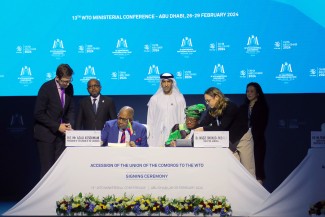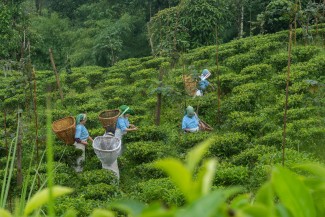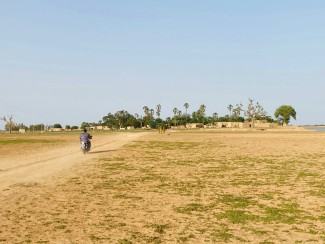|
|
|
The five specific targets of Sustainable Development Goal (SDG) 2 aim for improvements related to a range of issues. The targets are: end hunger (2.1); end all forms of malnutrition (2.2); double the agricultural productivity and incomes of small-scale food producers (2.3); ensure sustainable food production systems (2.4); and maintain genetic diversity (2.5).
This is ambitious, given the current situation.
According to the most recent estimates, 821.6 million, or one out of every 10 people in the world, are undernourished, and roughly 728 million people are estimated to be obese. And, there are 736 million people living in extreme poverty, with a majority engaged in the agri-food sector. At the same time, agricultural production systems face a number of environmental challenges related to soil health, greenhouse gas (GHG) emissions, land conversion, biodiversity loss, and water use and pollution.
Trade and related policies play a significant role in this context, as governments often use such measures to address food security as well as agricultural development objectives. Policies that can affect trade and markets include border measures like tariffs, export restrictions and non-tariff measures, as well as “behind-the-border” domestic support such as input and output subsidies, market price support, public investments in infrastructure and R&D, and some forms of income support programmes.
The domestic and international impacts of each of these policies can differ depending on whether the country is a net exporter or importer, a small or big producer or consumer, and the way in which policies are designed and implemented.
In addition, impacts may differ in the short versus longer run.
As policymakers consider using trade and related policies to achieve SDG 2, it is important to recognize that each of its targets – as well as trade itself – often constitute distinct policy priorities in many countries. As such, difficult trade-offs may exist between competing policy objectives.
ON COMPETING PRIORITIES
The use of export restrictions is an example of competing priorities of a border measure, in particular between short- and longer-run objectives within the domestic market, and between the policy objectives of two trading partners. Export restrictions are usually used to address domestic food security concerns related to rising food prices. Such measures often have the immediate effect of increasing food availability and lowering food prices in domestic markets, therefore contributing to the achievement of SDG targets 2.1 and 2.2. However, there might be negative implications for producer incomes (SDG target 2.3), which may be significantly reduced by lower food prices.
In the medium-to-long run, the initial effects of such a policy may be completely reversed as farmers respond to lower prices and policy uncertainty by decreasing cultivated areas. This can contribute to lower production and higher prices in the medium-to-long run, thus mitigating the initial positive implications of the measure for SDG targets 2.1 and 2.2. Furthermore, the application of export restrictions can undermine the achievement of SDG targets 2.1 and 2.2 in importing countries by lowering food availability on world markets and contributing to higher prices, particularly if measures are implemented simultaneously by many exporting countries.
As policymakers consider using trade and related policies to achieve SDG 2, it is important to recognize that each of its targets – as well as trade itself – often constitute distinct policy priorities in many countries. As such, difficult trade-offs may exist between competing policy objectives.
Behind-the-border measures such as input subsidies and market price support measures also involve important choices between different policy objectives. They can have positive implications for the achievement of SDG target 2.3 as they can improve farmer incomes. However, in addition to their high fiscal cost and administrative burden, they can negatively affect the achievement of SDG target 2.4, in particular if they provide production incentives for products with high GHG emissions.
In addition, there might be consequences related to SDG target 2.3 at an international level as such measures may lower prices and undermine the opportunity for small-scale producers in the importing country to sell their products in international markets.
RELATIONSHIP WITH MULTILATERAL TRADE RULES
Some measures generally have positive implications for the achievement of SDG 2 targets. These include public investments in infrastructure like storage facilities that can improve farmer prices (affecting SDG target 2.3), rural roads that can connect producers to markets (affecting SDG target 2.3), and efficiencies in trade and logistics that can reduce food waste and bring farm products where they are needed (affecting SDG targets 2.1 and 2.2).
As these measures do not typically involve transfers to individual producers, they usually fall under the World Trade Organisation (WTO) green box category and are not subject to any limitation. Moreover, the first means of implementation target of SDG 2 (i.e. 2.A), commits countries to “increase investment including through enhanced international cooperation, in rural infrastructure, agricultural research and extension services, technology development and plant and livestock gene banks…”
For other measures that can have production and trade-distorting effects, not only are they subject to limits in the multilateral trading system, but SDG 2’s other two means of implementation targets focus on improving the functioning of agricultural markets. In particular, target 2.B commits countries to “correct and prevent distortions in world agricultural markets, including through the parallel elimination of all forms of export subsidies and all export measures with equivalent effect…”
While progress on indicator 2.B has been made with the WTO Nairobi Ministerial Decision, achieving SDG 2 and resolving the trade-offs requires that governments go beyond a narrow focus on the elimination of export subsidies. Instead, policymakers need to take a broader approach to indicators of progress that encompass a range of measures that affect trade and markets in the global food system.
---------------------
Georgios Mermigkas is Economist and Ishrat Gadhok is Trade Policy Consultant at FAO.
If you would like to reuse any material published here, please let us know by sending an email to EIF Communications: eifcommunications@wto.org.



